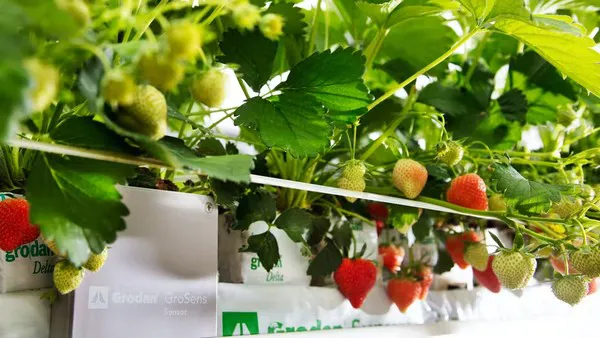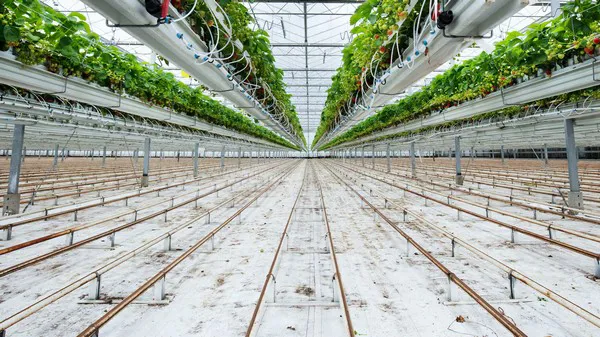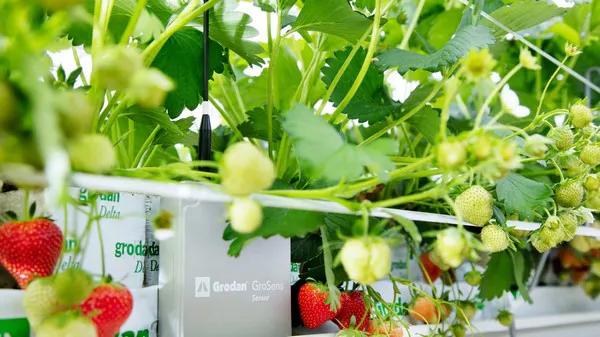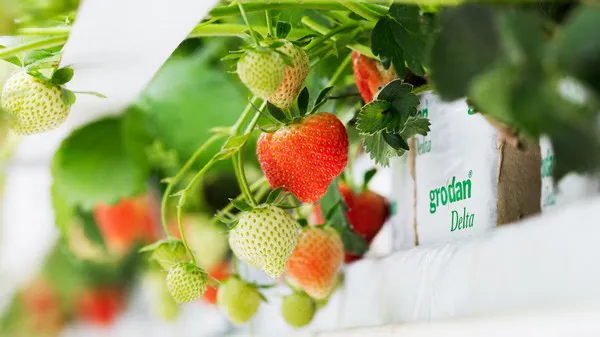The world of commercial strawberry growing is at a crossroads. Internal and external factors are pushing forward-looking growers like Genson to rethink their production practices, not least the substrate they use. In this context, a couple of years back, Genson asked independent expert, Elke Schellekens from Floraison, to lead a series of trials testing different substrates, including Grodan stone wool. The trials are still running, but Elke took a moment out from her busy schedule to reflect with the people at Grodan who’ve been involved with the trials on progress to date.

Genson Group is a major plant propagator/grower and a leader in the Dutch strawberry market, with clients including the country’s largest supermarket chain. Elke Schellekens is a soft fruit and flower mapping R&D expert. She looks at new varieties and how best to grow them. If a client wants to know anything, from optimal feeding schedules, to whether or not to cut leaves to the best tray plants to use, Elke will carry out the practical research to find the answer.

Old substrates problematic
Over the last 30 years or so, strawberry growers have made huge improvements to production, initially using peat and then coco substrates. But the use of such substrates is becoming increasingly challenging. Firstly, because legislation is tightening to address their environmental impact, for example, through peat excavation. But also because responsible growers themselves want to find more sustainable solutions. So Genson has set up trials to find out which other substrates, including stone wool but also, for example, wood-fiber substrates, may offer the solution for the future.
“The stone wool trials are now in their third year,” explains Elke, “We’ve had good results. There are obviously still things we need to fine-tune, but the results so far from the substrates being trialed suggest stone wool has great potential.”
Why is that? “When running a trial, we continuously tweak parameters, such as the feeding schedule and water levels, to pinpoint how to optimize a plant’s fruit production. With stone wool, you can do that very quickly and precisely. It’s also an environmentally-friendly solution.”
“Stone wool has some key characteristics that help improve production,” adds Maarten Coelen, Business Support Export Market at Grodan, who also has over a decade’s experience as a strawberry farm owner. “Primarily, its steerability, its hygiene, and the fact that stone wool doesn’t buffer any elements, so what you give a plant is directly available to it. And in terms of sustainability, stone wool has relatively low water usage, and recycling that water is relatively easy. Plus, there are various end-of-life solutions for stone wool, and in the Netherlands, 100% of used stone wool is already recycled.”

Propagation and steerability
Another key side of the trial process is looking at propagation, and here Elke’s expertise in flower mapping comes into play. “Flower mapping,” she explains, “is microscopic research where you look at such things as how advanced a developing truss is already formed inside the plant, how many flowers it has, whether it’s a more generative or more vegetative plant. And during the propagation stage, you can ‘steer’ the plant, for example through feeding, to get more or fewer flowers and thereby develop a plant with the properties the grower wants.”
During discussions of what makes stone wool such a strong candidate, one word that keeps cropping up is ‘steerability.’ Steerability is the degree to which you can precisely change parameters. For example, the water content levels in the substrate in response to climatic conditions. Or the level and composition of the nutrition. There is no fixation of nutrients within stone wool, making it very steerable. That’s important because if certain nutrients become fixated in the substrate, as they do in other traditionally used substrates, it’s very difficult to see just how much is being fixated or liberated and when in the process that’s happening. So you can’t properly measure the effect of the changes you introduce during the trials.

Another key aspect of these trials is the sensors. “The first year was definitely also a trial for the sensors,” confirms Elke. “They’re vital for monitoring areas such as the water content and EC levels. You also need to use a dripper system to get the water into the slab. Basically, using the sensors and stone wool just requires a whole different way of thinking about growing.”
New thinking
“Exactly!” enthuses Thomas Peters, Business Development Manager at Grodan. “The strawberry world needs to change, something the frontrunners in the industry are very aware of. And we believe stone wool can play a part in that change.”
The pressures for change are also coming from outside the industry. In the near future, all farms must have closed water systems. While land restrictions and growing consumer demand for local production suggest that indoor farming will be more prominent in tomorrow’s strawberry farming landscape. All additional reasons why a new growing media is needed for strawberries, and stone wool is increasingly looking like it can tick all the key boxes.

Promising results
But the bottom line is production results. “The trial results for both Class I and Class II fruit are very promising,” says Elke. “We’re also looking at things like bruisability, texture, taste, and sweetness (brix), and stone wool is scoring well on all these.” During the trials, the Favori variety has shown some very positive results, for example producing over 10kg of sellable fruit per running meter (6.1kg Class I).
But like any good scientist, Elke remains rightly cautious. “I believe stone wool has the potential to achieve what’s needed, especially looking at the sustainability aspects. But a lot of research is still needed. Not only into propagation and production but also the technical side of things. For example, we currently use the slabs in traditional gutters, but that’s probably not ideal for commercial production using stone wool. And having confirmed the strong benefits of stone wool as a substrate, we still now need to identify the optimal way to grow on it.”
Communication is key
Elke is also very positive about her experience working with her Grodan counterparts. “In the first year, everything about working with stone wool was all new to us: from how you treat it before planting to the feeding schedule, which is different than with other substrates, and on through the whole process. Grodan did a great job guiding us through all that. Good communication is critical during trials, and communication with the guys at Grodan has been really good so far. We’re now talking about where the focus and goals need to lie going forward.”
Talking about going forward, how does Elke feel about the trial’s future? “There are things to work on, but this is basically a great research program, and everything is looking positive: the berries, the higher production quantities…” And last but not least, the fact that with Elke running the trails, this most delicate of fruits is in very safe hands.
For more information: Grodan
Grodan
www.grodan.com
